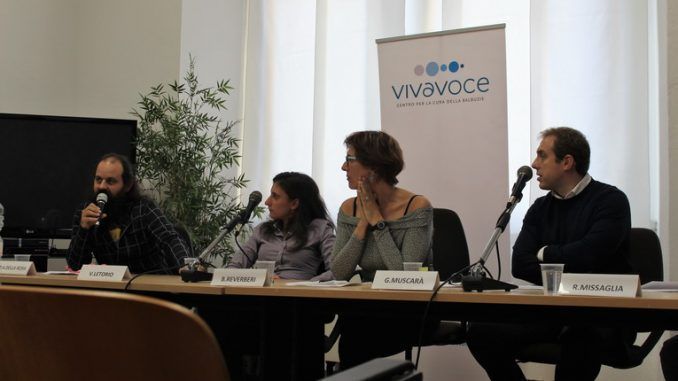
World Stuttering Day: a problem underestimated by one million Italians
«Raising awareness of stuttering – explains Valentina Letorio, neuropsychologist – it is not to be understood only in terms of making this disorder better known, reducing its profound social impact, but also promoting a greater understanding of this phenomenon and its causes; and this is the goal of World Stuttering Day, which is celebrated every year on October 22: to help people learn more about this disorder that affects 1 million Italians with an incidence of 8%.
World stuttering day: different definitions
There are several definitions of stuttering which are however based exclusively on the visible manifestations of the disorder, such as stops, repetitions and prolongations of a sound while speaking. Then there is loneliness, the difficulty of expressing oneself as one would like, with the consequent self-exclusion; as children we are ridiculed and bullied, at school there are double exams and at work, or in competitive contexts where the ease of being listened to often wins, frustrations are constant. To date, the most recent neuroscientific theories suggest that a malfunction in the motor control mechanism of speech is the basis of stuttering.
When a person speaks, he simultaneously exercises constant control of what he says to evaluate its correctness in terms of programming and sound production; if he perceives a mistake, he stops to try to produce the word or phrase correctly again ».
Development of methods and pathways to combat stuttering
The lack of unanimous consensus on the causes, combined with the complexity of the symptoms with which it manifests itself, has led to the development of methods and pathways to combat stuttering. In the Italian panorama, there are two main schools of thought: the first sees stuttering as a consequence of a childhood trauma or an altered emotional state and the rehabilitation practice therefore aims to fathom the emotional experiences linked to a trauma; the second, on the other hand, tries to overcome the typical blocks of stuttering through compensatory and replacement techniques based on the principle of singing.
«As a former stutterer – says Giovanni Muscarà, founder of the Vivavoce Institute – I have personally tried the most varied methods and courses to try to defeat stuttering. All the attempts I undertook were useless until, with the help of neurologists, neuropsychologists and physiotherapists, I developed a new method, the Muscarà Rehabilitation Method for Stuttering (MRM-S), which does not limit itself to teaching ways to avoid stuttering or to deal with the problem only from a psychological and emotional point of view, but which involves re-educating the person to regain control of the single movement necessary to produce a sound and manage language in a context of anxiety and stress. The re -education of stuttering, so that it is effective, a multidisciplinary approach that takes into account all the variables that come into play must provide “.
MRM-S method
The MRM-S method is a behavioral method (because it changes the behavior in the Eloquium) which is based on the principle of motor learning, that is, on the permanent change of behavior through practice and experience. In particular, the correct coordination between respiratory schemes, phonors and articulators allows to resume control of their movements and consequently of their own item. Once these motor schemes are learned, we intervene on the most emotional and behavioral aspect, identifying the daily situations experienced as stressful by the person and training the effectiveness of the new motor scheme learned in such situations.
Pasquale Anthony della Rosa, neuroscientist
“The MRM-S method-explains Pasquale Anthony della Rosa, neuroscientist, collaborates with the Pediatric Neuroradiology Unit of the San Raffaele Hospital-is the only method for stuttering in Italy to be subjected to scientific validation to objectively evaluate its effect on language control mechanisms, whose malfunction would be at the basis of stuttering.
The scientific validation study was divided into three different phases, the last of which has just been completed, evaluating the effects of the MRM-S on multiple components of language: attention, cognitive control, monitoring, phonoarticulation and behavior. The production of language, like every action, is the product of a mechanism, i.e. of a cognitive process, the result of the interaction of two systems: the first deals with the planning and execution of the act, the second controls, monitors , the correctness of this execution.
Imbalance between the two systems
In the event of an imbalance between the two systems, the action itself will not be effective. These studies demonstrate how in stutterers the component linked to control (monitoring) is characterized by an excessive level of activity, compromising the correct execution of the speech act itself, which then becomes dis-fluent. The MRM-S, in addition to acting on the purely linguistic component (verbal fluency), also intervenes on this cognitive imbalance, improving the performance of both programming and execution activities, as well as control.
Overall, the results of the scientific validation project of the MRM-S method introduce a new perspective on stuttering, broader than the traditional ones which frame it as a problem exclusively linked to its psychological or purely linguistic manifestations.
International Conference on Speech and Hearing Sciences
This broadening of perspective leads us to look at stuttering as a complex cognitive phenomenon, the solution of which therefore requires work on the person as a whole». The results of the first two steps of the project have already been presented at the International Conference on Speech and Hearing Sciences in Venice in November 2016 and at the International Conference for Cognitive Neuroscience (ICON) in Amsterdam in August 2017. The third step was submitted to the Budapest Ceu Conference on Cognitive Development to be held from 3 to 5 January 2019.
The timely diagnosis of this disorder, which on average begins between 2 and 3 years and which, in 88% of cases, regresses spontaneously within 6, is often difficult.
Rinaldo Missaglia, pediatrician and national secretary Simpef
«The stutter – Rinaldo Missaglia, Pediatrician and national secretary says Simpef, Medici union
Family pediatricians – is often not perceived by parents as a problem that can be brought
to the attention of the pediatrician. The family pediatrician has the tools to bring out this problem e
To undertake the diagnostic and therapeutic investigation process. These are the so -called visits to
Filter age included in the “Health Infancy Project” program, cornerstone of the assistance system
territorial pediatric.
To date, unfortunately, there is a lack of assistance for this disorder. In front of a child who
he stammers, our first reference is child neuropsychiatry and speech therapy. A first difficulty
assistance are the long waiting lists for access to specialists and for in-depth study
diagnosis and for subsequent therapeutic intervention.
Figure of the family pediatrician can become an important point of reference
Because the figure of the family pediatrician can become an important point of reference for
this disorder, it is necessary that the pediatricians themselves are updated and aware of this disorder e
on how it can be addressed. We therefore look with great interest and curiosity at the method
Muscarà as it could represent an opportunity to fill an information gap
authoritative sciences to tackle stuttering».
Defeating stuttering in under 18s, which in Italy are over 150.000, represents the possibility of
limit the social impact it has on young people but which can be repercussions in adulthood.
Gabriella Pozzobon, president of Sima
“In adolescence – concludes Gabriella Pozzobon, President of Sima, Italian Society of Medicine
of adolescence – in which many changes involve both the physique and the boys’ psyche in a challenge
Not simple in search of one’s identity, the presence of stuttering can undermine the already fragile
Psychological balance generating precariousness and insecurity.
Eloquio’s difficulty easily exposes the boy to be a victim of bullying, often pushing him to
avoid verbal expression and social withdrawal, as a form of defense from anxiety generated by situations
adverse, with consequent reduction of self -esteem and, in the most serious cases, impairment of the construction
self. This is the reason why in this age there is an increase in the number of requests for help and
a strong and conscious motivation, to which we are the responsibility to us to provide adequate and relevant answers “.


